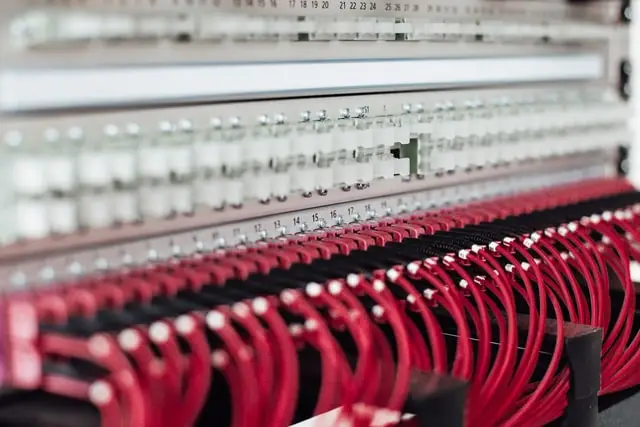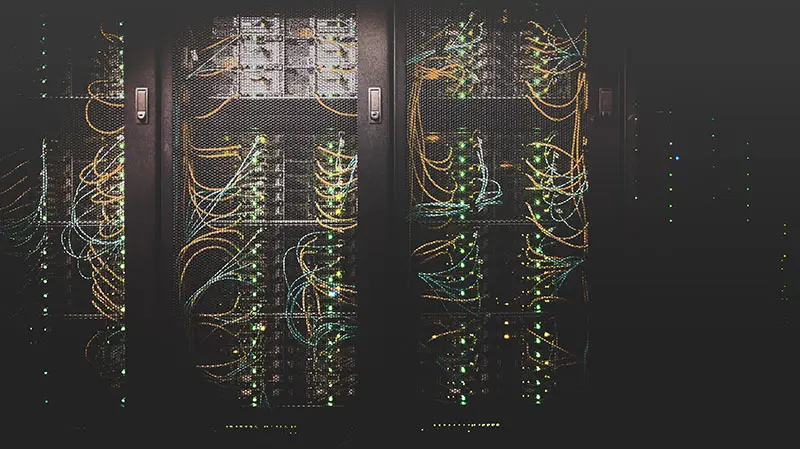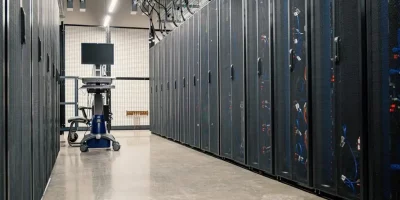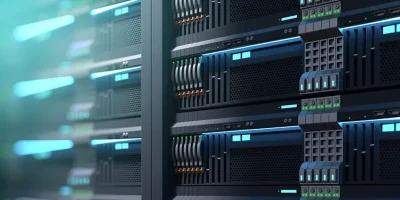Modern data centers are dedicated facilities where computer systems, data storage and associated telecommunications equipment are located as part of the information communication technology (ICT) infrastructure. This ICT infrastructure is typically located within a data center or more data halls (sometimes called computer or server rooms) and is powered by electrical systems and cooled by mechanical systems. This Mechanical & Electrical (M&E) equipment is located in rooms adjacent or close to the computer room(s).
If you enter any large data center you may encounter the following main elements which are all built to industry standards:
- Security throughout the facility with specific focus at the personnel and vehicle entrances
- Reception area – to confirm staff and visitors’ credentials and belongings
- ICT Equipment Room(s) – typically called data halls or computer rooms
- Telecommunications Room(s) – where telecoms carriers’ cables enter the building
- Electrical Rooms for the data center
- Mechanical Rooms (containing the air conditioning equipment)
- Battery Room(s) (in case of power failure)
- Generators for the data center (in case of power failure)
- Fire detection and suppression systems
- Operations department Control Room for the data center
Data Centre Equipment
At the heart of the data center, there are in many cases one or more data centers that house the computers, data storage and networking equipment. The majority of this data center equipment is small and is installed in purpose-built cabinets, however, in certain circumstances, the equipment is large enough to stand on its own within modern data centers. All of this equipment collectively generates a lot of heat into the data center that needs to be removed in order for the temperature within the data center to remain within the design specifications of the facility.
Traditionally, all of this equipment is organised into rows of cabinets and placed on a raised floor. This floor is made up of removable 600mm x 600mm floor tiles, which sit on pedestals at each corner of the tile, and dependent on design and size of the room, the height of this under-floor space can typically be from 250mm to 1000mm.
This enables two things; 1) it allows cold air to be blown into the under-floor space from air handling units and distributed across the full floor space and directed through floor grilles (as part of the raised floor). These grilles are placed at specific points that allow maximum efficiency for cooling the IT equipment in the room. 2) it provides a space for power subsystems and data cabling infrastructure to be run. The power cables provide electricity to the IT equipment and the data cables interconnect this equipment as required.
The above data center equipment description is only one of many designs within a modern data center . These can vary for a number of reasons but include the option to omit the raised floor and locate the equipment directly onto the floor ‘slab’. Also, overhead cabling is sometimes preferred – this is routed via overhead cable trays to the relevant equipment.
In data centers, you will also find services that provide lighting, smoke/fire detection and fire suppression systems, humidity control, access control and CCTV.
Infrastructure of a Data Centre
Outside of the data hall, there are systems that provide power and cooling to the data halls.
Electrical Infrastructure – Electric cables routed from the public power utility’s sub-station enter the data centres at very high voltage and travel through various transformers, automated and manual switches and distribution units and arrive at every piece of IT equipment cabinet at the correct voltage and capable of supporting all the equipment in that cabinet.
The electrical configuration will also include an Uninterruptible Power Supply (UPS). This consists of a bank of batteries and automatic switches and, in case of power failure, the batteries seamlessly take over the load immediately following the power failure. These batteries will only support the load for a few minutes but during this time, one or more diesel generators will automatically start and once fully running, they will take over the load until such a time when the utility power returns and is stable once again.
Mechanical Infrastructure – The cooling system consists of a number of different elements including external cooling towers or heat exchangers, chillers and air handling units – all interconnected using valves and pipework that either delivers cold water to where it is needed or removes hot water after it has been used to cool the data hall(s) and other necessary rooms.
Both the mechanical (cooling) and the electrical power supplies data center infrastructure can be configured to have various components that are not needed under normal operation but these will be used if a similar component develops a fault and has to be shut down. So, with this built-in redundancy, there is no effect to the operation of the IT equipment and, therefore, no impact on customer service. There are many various degrees of redundancy and resilience built into the M&E design – this being determined by the criticality of the business operations and processes.

The role of the data center
Data centers are sometimes referred to as server rooms and are an integral part of the enterprise, designed to support computing business applications and provide a service such as:
- Data, management, backup and recovery storage systems
- Productivity applications, such as email
- High-volume e-commerce computing transactions
- Powering online gaming communities’ storage systems
- Big data, machine learning and artificial intelligence
Today, there are reportedly more than 7 million data centers worldwide. Practically every business and government entity builds and maintains its own data centers or has access to someone else’s cloud services using colocation data centers.
Many options within various locations in the United Kingdom, United States and Europe are available today providing many applications, such as renting servers at a colocation facility, using services managed by a third party for your computing servers, or using a public cloud services provider from hosts like Amazon, Microsoft, Sony and Google or enterprise data centers to look after a companies computing business asset. In many cases, the data center facility has been designed to the uptime institute data center tiers levels 1-4 industry standards.
Data center architecture
Proper design of the data center infrastructure is precarious, and performance, scalability, and resiliency require to be carefully considered.
Another vital aspect of any data centers design is flexibility as quickly deploying and supporting new services. Designing of flexible architecture that can support new types of service applications in a very short period of time frame can result in a substantial competitive advantage. Such types of data center design need to be compact primary planning and attentive consideration in the areas of port density, access layer uplink bandwidth, server capacity, application performance and over-subscription, to name just a few.
The design for a data centre facility is built on a support infrastructure layered approach, which has been verified and improved over the past several years in some of the major data center employments in the world. The layered methodology is the elementary foundation of the data center design that improves, service, scalability, flexibility, performance, maintenance, and resiliency.
According to the architecture of data centers and the services they offer; there are three types of data centers
- Traditional Data Center
- Modular Data Center
- Cloud Data Center
Data Center Components:
The major components of a data center can be broken down into a few categories: power, cooling, security, fire suppression, fail-safe measures and room for growth.
Power: Next to cooling equipment, power is perhaps the most important detail of a data center. All of your servers, artificial intelligence, and applications equipment run off of a dedicated power source, power is the holy grail of every data center.
More to the point, beyond simply being able to provide power to equipment through PDUs, every data center needs to have redundant/backup power sources to ensure server and overall service uptime. Without redundant power supplies overhead or power subsystems, i.e. backup power generators, a data center is only as good as the local city grid it operates off. As we know, those city grids fail often.
Cooling: Just as important as power, proper cooling systems infrastructure in a data center allows your servers, networking gear and other public clouds, general web hosting or service provider equipment to function properly without overheating. Without proper infrastructure ventilation – raised floors to evenly spread cooling, hot/cold isles, – your server types would burn up and cease to function potentially losing your databases if not backed up. It is important to note, that just as power supplies within a data center need to be redundant, cooling also needs to be redundant.
Security: Beyond physical colocation servers and dedicated web servers, data centers function with a high level of security needs. Why? All of the servers, be they Cloud hosting servers or shared hosting accounts, house critical client data. Due to that, the security systems of a data center need to function around the clock.
For larger facilities, a good data center has resources to maintain 24/7/365 security staff, closed-loop surveillance cameras, fingerprint access and visitor log books. Moreover, data center security is a matter of physical security, i.e. being out of harm’s way. Physical data center security means building a data center outside of noted flood zones, outside of fault lines and outside of noted tornado alleys/hurricane paths.
Fail-Safe Measures: Another major component of data centers is fail-safe measures for all data stored within that data center. This means all data centers need to maintain and operate a backup data center wherein all data is replicated and stored. It is highly important for data center providers to supply a backup geo-diverse redundant data center facility and both facilities should be designed to an uptime institute tiered design in case of the main point of operations downtime.
Room For Growth: Investing in public cloud colocation, cloud services provider or dedicated servers is a long-term investment. As a long-term investment, you need to be able to grow with your demands as your company expands. All data center providers need to supply clients with the resources and infrastructure to allow the room they need to grow.
The above are the critical components of a well-qualified data center. When searching for a data center, clients should also look for the “soft” data center essentials like workplace room, mobile computer monitors, parking availability and (of course) food and drink
Uninterruptible Power Sources
An uninterruptible power source (UPS), also known as an uninterruptible power supply is a piece of equipment situated between electronics and the main power source and used to provide continuous and predictable power solutions.
Unlike a backup generator or other emergency power system, an uninterruptible power source provides immediate power with no noticeable interruption when the main power goes out and may protect against variations in voltage from the main power supply. In contrast, other emergency backup systems may take several minutes to begin operation after a power outage.
This difference is most important when dealing with some computers or high-powered electronics that need to be properly shut down, because sudden breaks in power while the equipment is running may physically damage them. It is important for users to check the limits of their equipment and not to overload the uninterruptible power source
Environmental control
In a data center, there are many pieces of hardware applications and equipment that make up the moving parts necessary to protect critical information. It is crucial to ensure that a facility is committed to keeping track of all infrastructure environmental variables for each piece of business asset equipment.
This helps the facility’s technical team resources remain aware of issues requiring corrective action, and machine learning and enables them to enact the preventative solutions necessary to avoid these issues in the future. Proper utilisation of these environmental monitoring tools will allow the data center provider to see what system is using which resources, in turn positioning the facility for optimal use.

The different kind of data centers
Modular data center
A modular data center references a deployment method and engineered solution for assembling a data center out of modular components in, many times, pre-fabricated solutions that enable scalability and a rapid delivery schedule. This can be either a panel system or a containerised solution and is used for enterprise data centers, cloud data centers, edge applications and colocation data centers within the United Kingdom. The system includes a complete redundant support infrastructure, security systems
Modcel
The ModCel Containerised Data Center is fabricated in a manufacturing facility in the United Kingdom and shipped to the end-user in the container. Most of the components in this type of data center are preinstalled, with many companies looking for immediate and reliable scaling solutions, containerised data centers provide flexibility to their user.
The flexibility of the ModCel containerized data centers, i. e. , adding new units as and when required, allows organizations to meet the fluctuating demands in a fast way.
- Containerised data centers have found applications in many sectors, catering to different needs. Disaster recovery remains one of the primary revenue-generating industries, with many organisations deploying data center containers to use computing power in areas struck with disasters. Temporary capacity elevation and high-performance computing are also significant applications for these data centers, with many users utilising them to handle additional loads without interrupting core systems. Easy scalability and high -power efficiency are supporting the deployment of this technology
- Further, these systems’ high mobility and scalability remain among the major driving factors for market growth.
A ModCel containerised data center is primarily defined as a modular data center incorporated into a bespoke shipping container or similar type of container. The containers are then fabricated with all the necessary components used in a data center, including cooling, power, and racks.






